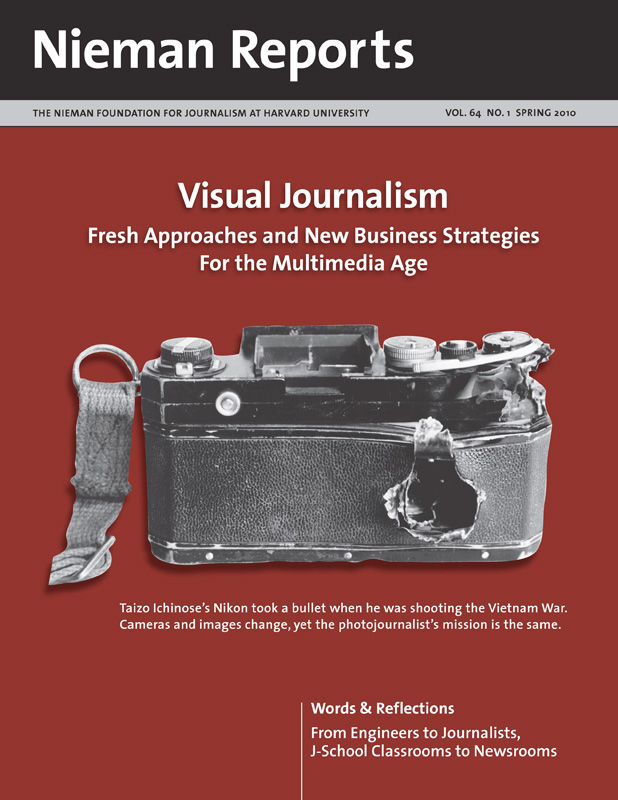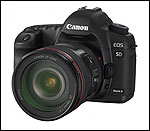Photojournalism is a remarkable mix of visual creativity and pictorial journalism—and, of course, technology. From the earliest efforts at permanent photography in the 1820’s, major developments in technology have shaped—and then reshaped—the ways in which photojournalists tell stories.
Relatively portable Speed Graphic cameras with their large and noisy flashbulbs allowed press photographers to document breaking news and work outside the studio. With the advent of 35mm cameras in the 1930’s, photographers could make images so quietly and quickly that they became “flies on the wall.” Advances in film sensitivity and “fast” lenses followed soon after and this meant that photographers could do their work in very low light and with no flash. Soon motor drives allowed multiple frames to be captured in sequence. Reliable autofocus began to appear for professional use around 1990—and was perfected a decade or so later—and negative scanners enabled film to be digitized and sent via modem across phone lines and finally via the Internet.
In the mid-1990’s, digital photography emerged. Since then improvements in resolution have brought us to the point at which major magazines now rely exclusively on digital images with no real deterioration in quality from what they achieved with film.
By the end of 2008 what photojournalists could do with a single camera took a quantum leap forward with the emergence of an easy-to-carry professional grade DSLR camera capable of shooting HD video. Now they can shoot video in high definition and gather audio with the same camera they use to shoot stills. And this changes everything. Photojournalists who not so long ago were limited to the powerful but mute still image can now explore an expansive range of storytelling possibilities. With the sound and movement of video, they are able to transport viewers into stories using these additional sensory lures. And video, well shot and edited, can convey context and emotion that are not always possible in the still image.
Yet the power and significance of still images remain in this transition to the multimedia presentation of stories. In this new form of storytelling, the element that often makes them work well is the skillful integration of—and sometimes the preponderance of—still images. They are effectively used either as the means of shaping the narrative arc or as visual punctuation marks. Given the visual expectations of today’s multimedia audiences, the hybrid camera is putting precisely the right tool in photojournalists’ hands—providing the perfect intersection of technology and sensibility.
Adding the How
So how does a global news organization such as The Associated Press (AP) get this technology working for us? In short, how do we train our photojournalists to use it?
It starts with a willingness to make a significant investment in the purchase of these new cameras. We spend $2,500-$4,000 per camera, depending on the model. Then we set up suitable in-house training to familiarize our photojournalists with the camera and some techniques to get them started. Our main objectives can be summarized as these: how to shoot video, how to edit video, and how to compress and deliver the stories to our clients.
Retraining photographers to shoot video can be more challenging than one imagines at first glance. New for them, for example, is the thought that now must go into sequencing and determining the length of the shot. We also teach them the importance of gathering different types of video so they will have the visual building blocks they’ll undoubtedly wish they had once they reach the editing process.
Despite their amazing capacity, these new cameras are small and inconspicuous—the same size as professional SLR cameras already on the market. This, we are finding, works to the advantage of photojournalists since they are already trained to get close to their subjects in an effort to become invisible. What we’ve discovered is that the subjects of these video efforts are relaxed and frank. The intimacy of the single camera—and the sensibilities that seem to come to those who use it—has prepared photojournalists well. They are able to garner better results than when subjects are confronted by a three-person crew with a large video camera.
Since many of our photographers have not done a lot of in-depth interviews with their subjects (often they only elicit information needed to put their subjects at ease or for captions), we devote time to teaching them how to ask questions to elicit fuller responses that just “yes” or “no.”
Learning how to edit is hugely important and highly difficult. The key to successful editing starts before the editing process even begins. A large part of our training focuses on helping our photographers know the story they want to tell. This can require a whole new way of thinking—something they must have for reasons as simple as this: For every story they intend to tell, they will often be the one who must figure out and shoot what will become the video’s opening and ending shots. We also teach about the value of cutaways as we explain—and demonstrate—how they are used to link elements of the story together.
Sound is vital—spoken and natural. So like radio journalists, for whom this skill resides at the top of their to-do list, our photojournalists will now be expected to give some thought to this element of their storytelling.
Compared to all of this learning about how they’ll think about and do their jobs in the field, the technical requirements are easy to teach. Compressing video and delivering it to the newsroom require technical calculations to ensure a good balance between image quality and ease of transmission. And as they did with their photos, they send video via File Transfer Protocol.
Experiencing the What
We’ve trained upward of 50 photographers and they’re now on assignment throughout the world. Usually their day job is to shoot stills and to shoot video when and where they can, but occasionally we ask them to concentrate exclusively on video.
When they shoot video—and create multimedia stories—for The AP, generally we use what they produce in three ways:
- As B-roll for inclusion in our broadcast television products where it will be mixed with other video from a variety of sources.
- As broadcast-style pieces for the Internet, usually one minute to one and a half minutes in length with an off-camera narrative voice. Still images are often included as visual punctuation in these stories.
- As long-form, protagonist-narrated stories, relying on natural sound when there is not a narrator’s voice. Destined for the Web, these video essays sometimes work for broadcast use as well and they incorporate a lot of still images.
RELATED ARTICLES
“Crossing the Line: From Still to Video—to Both at the Same Time”
– Julie Jacobson
“Gift of Training + Shift in Newsroom Thinking = Multimedia Storytelling”
– Evan VucciThe video essays are the most time-consuming photographer-generated genre to produce but often can be the most effective. Because they escape the TV conventions of
the narrator telling you what you are looking at, they represent a fresh approach to news coverage and literally transport the viewer into the story. Stories by two of our photographers, Julie Jacobson and Evan Vucci, illustrate how this happens.
This new type of camera—and on-the-road editing software—is a significant game changer that will allow already excellent visual journalists to do their jobs even more effectively on select stories. It does not signify the end of still photography; this will remain a powerful medium. Rather it gives us the capacity to enhance and deepen viewers’ understanding of the stories that we report on visually.
At a time when we are saturated with images—and when captions can easily be separated from the images they once accompanied, with the resulting confusion, it’s reassuring to be able to use emerging technology to provide visual context. To know that we are doing this in innovative ways reminds us of the opportunity we have been given to create new paths to telling the stories that people have always wanted to be told.
Santiago Lyon, a 2004 Nieman Fellow, is the director of photography at The Associated Press.



